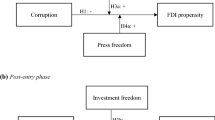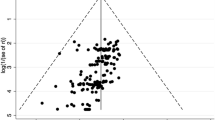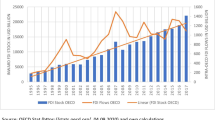Abstract
The paper provides a cross-country empirical analysis of the impact of corruption on foreign direct investment flows. The gravity model augmented with joint effects of corruption in the origin and destination countries determines differentiated patterns of investment flows between countries with various levels of control of corruption. The estimates point towards greater investment flows between countries with good control of corruption. Moreover, if control of corruption in the destination country improves, investment flows from cleaner countries rise more strongly than those from countries with a higher incidence of corruption. The resulting shift towards a greater share of investment from low-corruption countries may further reinforce the strengthening of economic and political institutions that keep corruption in check.
Similar content being viewed by others
Notes
See, for instance, http://www.bbc.co.uk/news/world-latin-america-17290626.
This is calculated as one standard deviation (1.07) times the difference between control of corruption scores in the respective countries (1.48) times the estimated coefficient on the interaction term in the fixed-effect specification (0.2).
Similar robustness checks for estimations based on the Eurostat data are available upon request.
References
Aidt, T. (2003). Economic analysis of corruption: A survey. The Economics Journal, 113, 632–652.
Anderson, J., & van Wincoop, E. (2003). Gravity with gravitas. American Economic Review, 93, 170–192.
Anderson, J., & van Wincoop, E. (2004). Trade Costs. Journal of Economic Literature, 42, 691–751.
Bellos, S., & Subasat, T. (2012a). Governance and foreign direct investment: A panel gravity model approach. International Review of Applied Economics, 26, 303–328.
Bellos, S., & Subasat, T. (2012b). Corruption and foreign direct investment: A panel gravity model approach. Bulletin of Economic Research, 64, 565–574.
Bellos, S., & Subasat, T. (2013). Governance and foreign direct investment in Latin America: A panel gravity model approach. Latin American Journal of Economics, 50, 107–131.
Bergstrand, J., & Egger, P. (2011). Gravity equations and economic frictions in the world economy. In D. Bernhofen, R. Falvey, D. Greenaway, & U. Kreickemeier (Eds.), Palgrave handbook of international trade. London: Palgrave Macmillan Publishing.
Blonigen, B. (2005). A review of the empirical literature on FDI determinants. Atlantic Economic Journal, 33, 383–403.
Brainard, S. (1997). An empirical assessment of the proximity-concentration trade-off between multinational sales and trade. American Economic Review, 87, 520–544.
Cazer, R., & Escobar, O. R. (2015). Institutional distance and foreign direct investment. Review of World Economics, 151(4), 713–733.
Chakrabarti, A. (2001). The determinants of foreign direct investments: Sensitivity analyses of cross‐country regressions. KYKLOS, 54, 89–114.
Chinn, M., & Ito, H. (2006). What matters for financial development? Capital controls, institutions, and interactions. Journal of Development Economics, 81(1), 163–192.
Globerman, S., & Shapiro, D. (2002). Global foreign direct investment flows: The role of governance infrastructure. World Development, 30, 1899–1919.
Gouel, C., Guimbard, H., & Laborde, D. (2012). A foreign direct investment database for global CGE models (CEPII Working Paper 2012-08).
Habib, M., & Zurawicki, L. (2002). Corruption and foreign direct investment. Journal of International Business Studies, 33, 291–307.
Hausmann, R., & Fernández-Arias, E. (2000). Foreign direct investment: Good cholesterol? (Inter-American Development Bank Working Paper 4203).
Head, K., & Mayer, T. (2013). Gravity equations: Workhorse, toolkit, and cookbook (CEPII Working Paper 2013-27).
Head, K., & Ries, J. (2008). FDI as an outcome of the market for corporate control: Theory and evidence. Journal of International Economics, 74, 2–20.
Henisz, W. (2000). The institutional environment for multinational investment. Journal of Law Economics and Organization, 16, 334–364.
Javorcik, B., & Wei, S. (2009). Corruption and cross-border investment in emerging markets: Firm-level evidence. Journal of International Money and Finance, 28, 605–624.
Kaufmann, D., Kraay, A., & Zoidoo-Lobaton, P. (1999). Governance Matters (World Bank Policy Research Working Paper No. 2196).
Kaufmann, D., & Wei, S. (1999). Does ‘grease money’ speed up the wheel of commerce? (NBER Working Paper No. 7093).
Kinda, T. (2010). Investment climate and FDI in developing countries: firm-level evidence. World Development, 38, 498–513.
Koczan, Z., & Plekhanov, A. (2013). How important are non-tariff barriers? Complementarity of infrastructure and institutions of trading partners (EBRD Working Paper 159).
Long, C., Yang, J., & Zhang, J. (2015). Institutional impact of foreign direct investment in China. World Development, 66, 31–48.
Lui, F. (1985). An equilibrium queuing model of bribery. Journal of Political Economy, 93, 760–781.
Mauro, P. (1995). Corruption and growth. Quarterly Journal of Economics, 110(3), 681–712.
Rajan, R., & Zingales, L. (1998). Financial dependence and growth. American Economic Review, 88(3), 559–586.
Ramondo, N., Rappoport, V., & Ruhl, K. J. (2013). Horizontal versus vertical foreign direct investment: Evidence from U.S. multinationals. UC San Diego typescript manuscript.
Stein, E., & Daude, C. (2001). Institutions, integration and the location of foreign direct investment, OECD Global Forum on International investment. New Horizons and Policy Challenges for Foreign Direct Investment in the 21st Century: OECD Publishing.
Wei, S. (1997). Why is corruption so much more taxing than tax? Arbitrariness kills (NBER Working Paper No. 6255).
Wei, S. (2000). How taxing is corruption on international investors? The Review of Economics and Statistics, 82, 1–11.
World Bank. (2012). Fighting corruption in public services: chronicling Georgia’s reforms. Washington, DC: World Bank.
Acknowledgements
The authors are grateful to Erik Berglöf, Ralph de Haas, Jeromin Zettelmeyer, Cagatay Bircan, Sergei Guriev, Yothin Jinjarak, Teodora Tsankova, Roxana Mihet, Jeffrey Mo, Ganeshan Wignaraja, the editor and the anonymous referees for valuable comments and suggestions.
Author information
Authors and Affiliations
Corresponding author
Additional information
Publisher's Note
Springer Nature remains neutral with regard to jurisdictional claims in published maps and institutional affiliations.
Appendix
Appendix
1.1 List of countries in the sample
Albania, Algeria, Angola, Antigua and Barbuda, Argentina, Armenia, Aruba, Australia, Austria*, Azerbaijan, Bahrain, Bangladesh, Barbados, Belarus, Belgium*, Belize, Benin, Bolivia, Bosnia and Herzegovina, Botswana, Brazil, Bulgaria*, Burkina Faso, Burundi, Cabo Verde, Cambodia, Cameroon, Canada, Central African Republic, Chad, Chile, China, Colombia, Costa Rica, Croatia*, Cyprus*, Czech Republic*, Denmark*, Dominica, Dominican Republic, Ecuador, Egypt, El Salvador, Equatorial Guinea, Eritrea, Estonia*, Ethiopia, Fiji, Finland*, France*, Eritrea, Gabon, Georgia, Germany, Ghana, Greece*, Guatemala, Guinea, Guinea-Bissau, Guyana, Haiti, Honduras, Hong Kong SAR, Hungary*, Iceland*, India, Indonesia, Ireland*, Islamic Republic of Iran, Israel, Italy*, Japan*, Jordan, Kazakhstan, Kenya, Korea, Kuwait, Kyrgyz Republic, Lao P.D.R., Latvia*, Lebanon, Liberia, Libya, Lithuania*, Madagascar, Malawi, Malaysia, Maldives, Mali, Malta*, Marshall Islands, Mauritania, Mauritius, Mexico, Moldova, Mongolia, Morocco, Mozambique, Namibia, Nepal, Netherland*s, New Zealand, Nicaragua, Niger, Nigeria, Norway*, Oman, Pakistan, Panama, Papua New Guinea, Paraguay, Peru, Philippines, Poland*, Portugal*, Qatar, Republic of Congo, Romania*, Russian Federation, Rwanda, Saint Kitts and Nevis, Samoa, Saudi Arabia, Saint Lucia, Senegal, Seychelles, Sierra Leone, Singapore, Slovak Republic*, Slovenia*, Solomon Islands, South Africa, Spain*, Sri Lanka, Sudan, Suriname, Swaziland, Sweden*, Switzerland*, Tajikistan, Tanzania, Thailand, The Bahamas, The Gambia, Togo, Trinidad and Tobago, Tunisia, Turkey*, Uganda, Ukraine, United Arab Emirates, United Kingdom*, United States*, Uruguay, Uzbekistan, Venezuela, Vietnam, Yemen, Zambia, Zimbabwe.
Note: Countries marked with * are reporter countries in the Eurostat database.
1.2 Correlation coefficients
See Table 6.
About this article
Cite this article
Belgibayeva, A., Plekhanov, A. Does corruption matter for sources of foreign direct investment?. Rev World Econ 155, 487–510 (2019). https://doi.org/10.1007/s10290-019-00354-1
Published:
Issue Date:
DOI: https://doi.org/10.1007/s10290-019-00354-1




